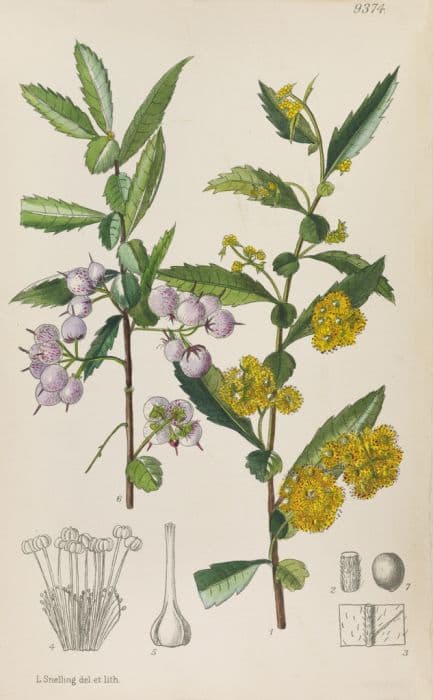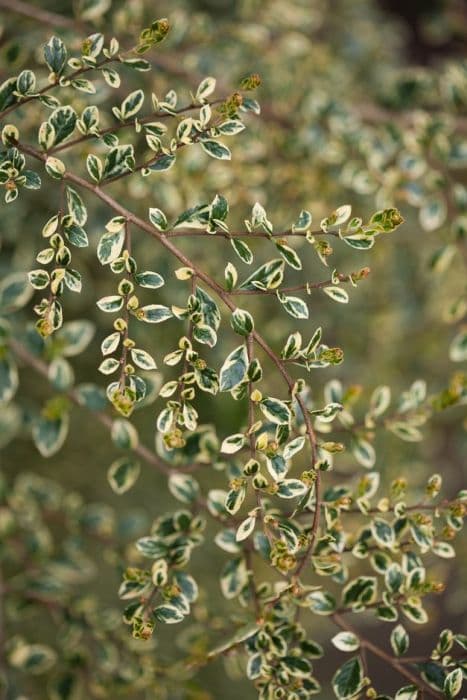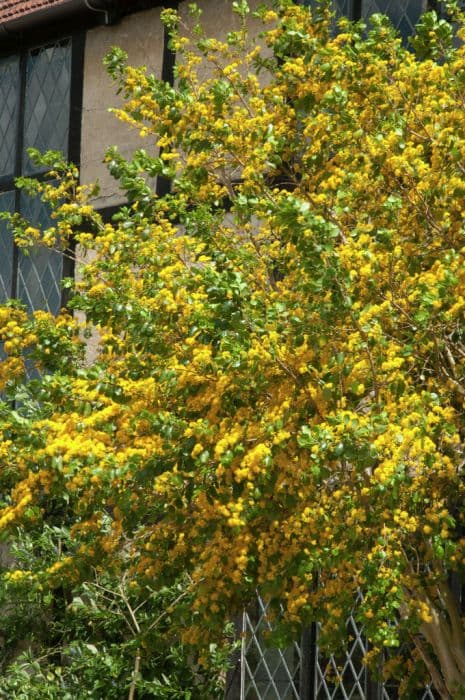Golden Willow Salix alba var. vitellina

ABOUT
Salix alba var. vitellina, commonly known as the golden willow, is a plant known for its striking appearance. It is characterized by its bright yellow branches that add a warm, glowing color to the landscape, especially noticeable during winter months when contrasted against the barren surroundings. The branches can be quite flexible and are often used in basket weaving. The leaves of the golden willow are elongated and slender, with a somewhat lance-shaped look. They exhibit a fine-toothed margin. During the growing season, the foliage presents a lush green color that transitions to yellow in the fall, complementing the yellow of the branches. The contrast between the golden branches and green leaves is one of the most distinctive features of this plant during the spring and summer months. The bark of the golden willow is typically rough and furrowed, providing textural interest throughout the year. In terms of the plant's reproductive elements, it produces flowers known as catkins, which appear in early spring before the new leaves emerge. These catkins add to the ornamentality of the plant with their soft, silver-white appearance that turns yellow as the pollen develops. The golden willow is often found near water sources such as streams or ponds, as it prefers moist environments, which also contributes to its lush appearance. The plant's attractive form, combined with its colorful display, makes it a popular choice for gardeners looking to add year-round visual interest to their landscapes without needing to rely on floral blooms. Whether seen swaying gracefully in the breeze or standing out amidst the winter snow, the golden willow's unique appeal is undeniable.
About this plant
 Names
NamesSynonyms
Golden Willow, Yellow Willow, White Willow
Common names
Salix alba subsp. vitellina, Salix alba var. britzensis.
 Toxicity
ToxicityTo humans
White willow is not considered highly toxic to humans. However, care should be taken as the bark contains salicin, which is chemically similar to aspirin. Some individuals, particularly those with sensitivity to aspirin or those who are allergic, can experience adverse reactions. Ingestion of large quantities of bark may lead to symptoms such as stomach discomfort, nausea, vomiting, or more serious effects such as ulcers, bleeding, or kidney impairment. It is advisable for people with known allergies or sensitivities to aspirin to avoid consuming parts of this plant.
To pets
White willow in general is not highly toxic to pets. The bark contains salicin, which is similar to aspirin. Pets, particularly dogs and cats, may experience gastrointestinal upset including vomiting or diarrhea if they consume large quantities of the bark. In cases of significant ingestion, more severe symptoms such as stomach ulcers or kidney problems could occur. It is advisable to prevent pets from ingesting this plant, especially if they have a known sensitivity to aspirin or other salicylates.
 Characteristics
CharacteristicsLife cycle
Perennials
Foliage type
Deciduous
Color of leaves
Green
Flower color
Yellow
Height
50 feet (15 meters)
Spread
30 feet (9 meters)
Plant type
Tree
Hardiness zones
3
Native area
Europe
Benefits
 General Benefits
General Benefits- Erosion Control: The robust root system of the white willow helps stabilize riverbanks and other areas susceptible to erosion.
- Wildlife Habitat: Provides food and shelter for birds, insects, and other wildlife.
- Ornamental Value: Bright yellow stems add visual interest to landscapes, especially in winter.
- Soil Improvement: Falling leaves and twigs decompose to enrich the soil with organic matter.
- Habitat Diversity: Can be part of mixed planting schemes that increase biodiversity in an area.
- Shade and Shelter: Large canopy offers shade and windbreak benefits, creating microclimates for humans and wildlife.
- Sound Barrier: Dense foliage can help reduce noise pollution when planted in groups alongside busy areas.
- Sustainable Wood Source: Fast-growing nature makes it a resource for renewable wood products.
- Streambank Stabilization: Plantings can help reduce the speed of runoff and filter out pollutants from entering waterways.
 Medical Properties
Medical Properties- Analgesic: Salix alba var. vitellina, commonly known as White Willow, contains salicin which is a precursor to salicylic acid, a compound similar to aspirin that may help reduce pain.
- Anti-inflammatory: The salicin in White Willow may also act to reduce inflammation, making it potentially useful for conditions such as arthritis.
- Antipyretic: Due to its aspirin-like contents, White Willow may help in reducing fever.
- Astringent: The bark of White Willow has astringent properties and may be used for its toning effect on the skin.
- Antiseptic: White Willow bark may also possess antiseptic properties, contributing to its traditional use in wound care.
- Rheumatic relief: It may be used traditionally to alleviate symptoms of rheumatic conditions due to its anti-inflammatory and analgesic effects.
- Headache relief: Historically, the bark has been used to relieve headaches again due to the salicin content.
- Menstrual cramp relief: The plant's compounds may help ease menstrual cramps through their muscle relaxant and analgesic effects.
 Air-purifying Qualities
Air-purifying QualitiesThis plant is not specifically known for air purifying qualities.
 Other Uses
Other Uses- Salix alba var. vitellina, commonly known as Yellow Willow, can be used for basketry due to its flexible stems that can be woven into intricate patterns and structures.
- The long, straight stems of the Yellow Willow make it suitable for traditional fencing techniques, such as wattle hurdles, providing an environmentally friendly fencing option.
- Yellow Willow branches are utilized in the production of charcoal, often favored by artists for its fine and consistent quality.
- The wood of the Yellow Willow is appreciated for its use in crafting cricket bats, as it has shock-absorbing qualities beneficial for the sport.
- Young stems from this willow variety can be used in the ancient technique of living willow sculptures, where the stems are planted and grown into various ornamental or functional shapes.
- In some cultures, the flexible branches of the Yellow Willow are made into traditional musical instruments, such as flutes or whistles.
- The Yellow Willow displays vivid yellow twigs which are harvested and used in the floral industry, especially to create colorful winter arrangements.
- Because of their dense root systems, these willows are planted for soil stabilization along riverbanks, helping to combat erosion and support the integrity of the riverine environment.
- The bark of the Yellow Willow can be stripped and processed to create high-quality craft paper, offering a sustainable resource for papermaking.
- Yellow Willow can be incorporated in landscape design, not just for its ornamental value, but also for creating natural windbreaks in open or windy areas.
Interesting Facts
 Feng Shui
Feng ShuiThe White Willow is not used in Feng Shui practice.
 Zodiac Sign Compitability
Zodiac Sign CompitabilityThe White Willow is not used in astrology practice.
 Plant Symbolism
Plant Symbolism- Flexibility and Resilience: The Salix alba var. vitellina, commonly known as the Golden Willow, is known for its flexible branches that bend without breaking. This characteristic symbolizes the ability to adapt and recover from challenges without losing one's integrity.
- Healing: Historically, the willow has been associated with healing due to the salicylic acid found in its bark, which is a precursor to aspirin. It represents the potential for physical and emotional healing.
- Growth and Renewal: Willows are fast-growing trees, often one of the first to sprout leaves in spring. This symbolizes new beginnings and the promise of renewal after hardship or loss.
- Sorrow and Mourning: The weeping form of some willow varieties has led to its association with sorrow and mourning, representing grace and the expression of deep emotions.
- Wisdom and Learning: In some cultures, the willow tree is a symbol of wisdom, knowledge, and learning, possibly due to its long lifespan and enduring nature.
 Water
WaterThe Golden Willow (Salix alba var. vitellina), thrives with regular watering, especially when young and establishing its root system. During its growing season, it should be watered deeply once or twice a week, depending on the weather conditions. A good rule of thumb is to provide the Golden Willow with about 2-3 gallons of water each watering session for young trees, increasing to 5-10 gallons for more mature trees. The soil should be kept moist but not waterlogged. During the winter, you can reduce watering since the tree is dormant and the cooler weather reduces the rate of evaporation.
 Light
LightThe Golden Willow prefers full sunlight conditions and should be planted in a spot where it can receive at least 6 hours of direct sunlight each day. This tree thrives in open areas where it can get unfiltered sunlight, which is important for its growth and the development of its bright yellow stems.
 Temperature
TemperatureThe Golden Willow is quite hardy and can survive in a wide range of temperatures. It can endure temperatures as low as -30 degrees Fahrenheit and as high as 100 degrees Fahrenheit. However, the ideal temperature for this willow is between 50 and 75 degrees Fahrenheit.
 Pruning
PruningThe Golden Willow should be pruned to maintain shape, remove dead or diseased branches, and encourage the characteristic yellow twigs for which it is known. Pruning is best done in late winter or early spring before new growth starts. Generally, annual pruning is sufficient, but if the tree is used for its twigs in decorative arrangements, more frequent pruning may be necessary to stimulate the growth of new shoots.
 Cleaning
CleaningNot needed
 Soil
SoilThe best soil mix for a Golden Willow is well-draining and slightly acidic to neutral in pH, ranging from 6.0 to 7.0. It should be rich in organic matter, so incorporating compost or well-rotted manure will benefit the tree's growth. An ideal mix might consist of garden soil, peat moss, and perlite or sand to ensure proper drainage.
 Repotting
RepottingGolden Willows, being large trees, are not typically repotted. Instead, they are planted outdoors where they have ample space to grow. In the rare case they are grown in a very large container or pot, they should only be repotted when absolutely necessary due to size constraints, potentially every 3-5 years.
 Humidity & Misting
Humidity & MistingGolden Willows are tolerant of a wide range of humidity conditions and do not require specific humidity levels when grown outdoors in their natural environment. They thrive with regular rainfall and can tolerate occasional flooding.
 Suitable locations
Suitable locationsIndoor
Golden Willows are poor choices for indoor growth; they're large trees.
Outdoor
Plant in sun, moist soil; prune in late winter.
Hardiness zone
2-9 USDA
 Life cycle
Life cycleSalix alba var. vitellina, commonly known as the golden willow, begins its life cycle with seed germination, which usually occurs in moist, sandy, or silty soils in spring. The seeds sprout to form seedlings that rapidly grow into young saplings, showing vigorous growth and an affinity for wet, riparian zones. As the sapling matures into an adult tree, it develops a robust root system and the characteristic yellow twigs for which it is named. The golden willow reaches reproductive maturity within a few years, producing flowers known as catkins that appear in early spring before the leaves; these are wind-pollinated and primarily dioecious, meaning individual trees are typically male or female. After pollination, female trees bear small capsules containing numerous tiny seeds that are dispersed by wind and water. The golden willow's life span can extend up to several decades, during which it may undergo cycles of pruning or coppicing, encouraging new growth from the stump and maintaining its health and vigor.
 Propogation
PropogationPropogation time
Late Winter to Early Spring
The most popular method for propagating the White Willow, scientifically known as Salix alba var. vitellina, is through hardwood cuttings. This is typically done during the winter when the tree is dormant. To propagate, one should select healthy, mature stems from the current or previous year's growth. Cuttings should be about 9 to 12 inches (23 to 30 centimeters) long and approximately half an inch (1.3 centimeters) in diameter. The base of each cutting is then inserted into a prepared soil bed or potting mixture, ensuring that at least two-thirds of its length is submerged. The soil should be kept moist until roots develop, which may take several weeks. Once rooted, the cuttings can be transplanted to their permanent location where they will grow into new White Willow trees.









